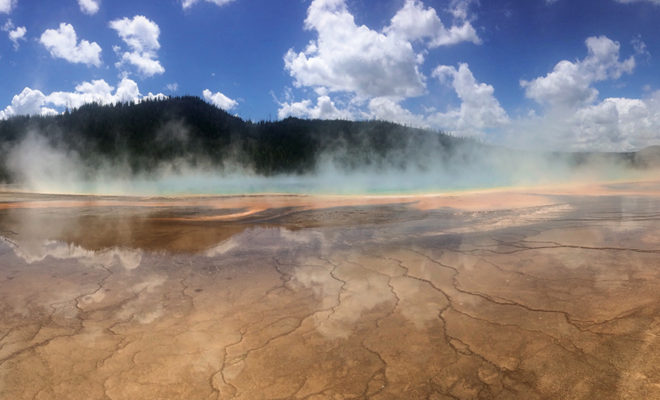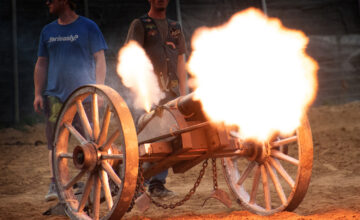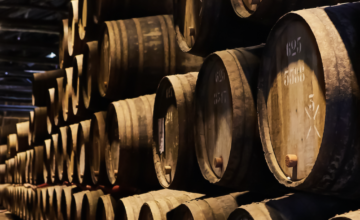(Hotly) Debated by Will Craft and Liam Jones
Position One
Here’s the thing. From 2004 to 2008, Yellowstone—the whole place—rose a foot. Scientists are freaking about it. IT’S A FREAKING FOOT.
Have these so-called “geologists” even heard of Gannett Peak? The Grand Teton? Cloud Peak?
Yellowstone National Park sits at roughly 8,000 feet, including that extra foot it grew. Gannett, Teton, and Cloud tower above that by an average of around 5,000 feet. That’s something like 162 percent the height of Yellowstone, on average. I’m not at all sure why someone who went to some fancy school and got some fancy degree, and they’re now called “Dr.,” even though they can’t tell me if this thing on my leg is benign or not, can call this thing—a Park for cryin’ out loud—a supervolcano, just because it has a bunch of hot springs and little magma pocket things.
The other “evidence” that people are using to try and disgrace the beauty that surrounds the Old Faithful Gift Shop and those deliciously protected buffalo are earthquakes.
Since when does an earthquake indicate volcanic activity? Some of the most recent sizable earthquakes in the United States have been in Oklahoma. Recent, that is, as of May. There are no volcanoes there. Just ask Wikipedia.
There’s no correlation. It’s a coincidence. It’s gotta be.
Now that I think about it, how are we supposed to know that the government isn’t making this stuff up to scare us into paying more taxes, huh? It’s a ploy, a scam, and I’d bet money that Russia’s involved.
Beyond the probability that this evidence isn’t even valid (where’s the proof?), why would anyone want to believe that Yellowstone poses a threat? Have you ever even been there? It’s awesome. It haseverything! Rivers, deer, bears, grasses, magma craters, trees, and a few wolves, if those things are still even around. It’s the land of plenty, where anyone can go to immerse themselves in the outdoors. Take a breath of fresh air and be one with nature. Anything goes, except for anything that could be destructive to the park. Oh, and don’t try to put any buffalo in your car. No good will come of that.
Yellowstone National Park was created in 1872. Originally, this explorer dude named Ferdinand Vandeveer Hayden tried to go to Yellowstone from the East when the West was still virtually uncharted. He wanted to, well, chart the place. He’d heard about some cool geysers,bears and a cool hotel—or something like that.
The first try didn’t really work out.
Ultimately, he got back East and the convinced Congress to create the world’s first National Park based on the surveys, photos, and paintings he returned with. That bill, “The Act of
Dedication,” was signed into law, creating Yellowstone National Park, by none other than Ulysses S. Grant.
Why does that matter?
Well, Mr. Grant—excuse me, President Grant—excuse me again, President General Mr. Grant, was the commander of the Union Army in the Civil War. This man was a strategist and a master of the battlefield. Did he have some close calls, some missteps? Sure he did. But he won. He was a winner, dammit. Not only that, but he was a faithful patriot. He believed in the strength of the Union, of our United States of America, as did his friend and commander-in-chief, Abraham Lincoln.
What these scientists are suggesting with their ground risings and volcanic earthquakes is that Mr. President General Ulysses S. Grant was one of two things. Either he was an idiot, or a sadist with contempt for future Wyomingites.
If you’re suggesting that Yellowstone is dangerous, perhaps you hate Ulysses S. Grant, and Abraham Lincoln, and even Wyoming. Or are you just jealous because you’re not on any money?
Position Two
We live an ephemeral world, my friends. Nothing in this cruel life is assured, and more than likely we’ll all die well before we think we will. We’re not here to discuss the ultimate, unfortunate nihilistic truths that govern our world and crush our spirits, no that’s not why we’re here. We wouldn’t go on and on about how the only things that separate us from the animal world is our own antiquated sense of purpose and morality, and that at the end, human bones blanch in the uncaring desert sun the same as any other animal. No, we wouldn’t do that. Because that would be depressing.
On the subject of something only slightly less depressing, we have the Yellowstone Supervolcano, a cauldron of nonsense and geological hatred bubbling in the North-Western corner of our fair state. We face a lot of existential threats to our safety nowadays: terrorism, climate change, weaponized tarantulas. Yet, in this humble writer’s opinion, there is no greater imminent death threat than Yellowstone itself. The entiery of the national park is essentially some cool geysers and a bunch of wolves sitting on top of large pockets of magma. The hot springs and seismic activity in Yellowstone are fueled by the churning mass of red-hot death desperately trying to find its way out of the ground. Recently, there has been a marked uptick in tectonic buggery in and around Yellowstone, news that has understandably rattled a few nerves.
The earth was last rocked with an eruption from the caldera more than 70,000 years ago, which may seem comforting at first, but that means we are well overdo for one. Do you know what would happen if Yellowstone erupted? 87,000 people would die outright. The lava would destroy everything in its path, and the eruption would essentially rain down natural artillery on our unforunate heads. That’s nothing compared to the pyroclastic flow. Gas hot enough to insantly evaporate all of the water from a human body (see Pompeii) and tephra, fragmented rock material, gathers in a cloud of destruction that can travel for miles and travel at hundreds of miles per hour. Toxic ash would rain from the sky, and 2/3 of the United States would be rendered instantly uninhabitable, say nothing of Canada. Poor, poor Canada. The blast would belch so much sulfur dioxide and other gases into the atmosphere that the resulting climate cool could last up to 10 years.This would affect rainfall patterns, atmospheric oxygen content, and would cause frosts so severe that crop loss and mass famine would be the only menu options.
The unfortunate reality of the Yellowstone Caldera is no Russian conspiracy, my friends. Unlike geopolitical or other climate-based apocalypse scenarios, there’s not a single thing we can do about it. You can pray, you can hide, you can make blood sacrifices, but when that lid blows, we’re all going down.





Marlene Howard
February 11, 2018 at 12:46 pm
Our family is planning on visiting Yellowstone National Park this summer. I would like a travel magazine with points of interest so we can plan our adventure. Group ages 8 years to 65 years of age